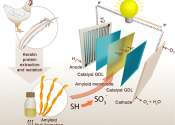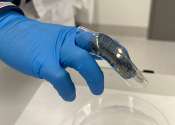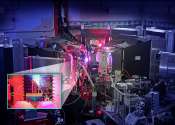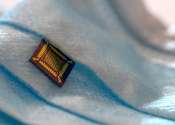Hi Tech & Innovation news
Energy & Green Tech
Researchers 3D print high-performance, sustainable thermoelectric materials
Rapid, localized heat management is essential for electronic devices and could have applications ranging from wearable materials to burn treatment. While so-called thermoelectric materials convert temperature differences ...
Feb 20, 2025
0
25
Electronics & Semiconductors
First two-way adaptive brain-computer interface enhances communication efficiency
A team of bioengineers at Tsinghua University, working with medical research colleagues from Tianjin University, both in China, have developed what they describe as the world's first two-way adaptive brain–computer interface ...
Feb 20, 2025
0
38

High-speed face tracking enhances augmented reality experiences
Augmented reality (AR) has become a hot topic in the entertainment, fashion, and makeup industries. Though a few different technologies exist in these fields, dynamic facial projection mapping (DFPM) is among the most sophisticated ...
Feb 20, 2025
0
31

Giant X-ray facility shows that magnets can reduce flaws in 3D printed components
Safety critical components for aircraft and Formula 1 racing cars could one day be 3D printed via a new technique, developed by researchers at UCL and the University of Greenwich, that substantially reduces imperfections ...
Feb 20, 2025
0
0

Chip-based system for terahertz waves could enable more efficient, sensitive electronics
The use of terahertz waves, which have shorter wavelengths and higher frequencies than radio waves, could enable faster data transmission, more precise medical imaging, and higher-resolution radar.
Feb 20, 2025
0
30
Robotics
Bio-hybrid drone uses silkworm moth antennae to navigate by smell
Conventional drones use visual sensors for navigation. However, environmental conditions like dampness, low light, and dust can hinder their effectiveness, limiting their use in disaster-stricken areas. Researchers from Japan ...
Feb 19, 2025
0
22
Energy & Green Tech
3D-printed coffee and mushroom mix offers compostable plastic alternative
Only 30% of a coffee bean is soluble in water, and many brewing methods aim to extract significantly less than that. So of the 1.6 billion pounds of coffee Americans consume in a year, more than 1.1 billion pounds of grounds ...
Feb 18, 2025
0
27
Engineering

Harnessing failure as an asset: How researchers are innovating smarter wearable tech
In the world of soft robotics and wearable technology, sheet-based fluidic devices are revolutionizing how lightweight, flexible and multifunctional systems are designed. But with innovation comes challenges, particularly ...
Feb 18, 2025
0
6
Hi Tech & Innovation

Synaptic device array integrates sensing, memory, and processing for artificial vision
In a development for artificial intelligence, researchers have unveiled a synaptic device array that shows promise for enhancing artificial visual systems. This innovative array, measuring a compact 0.7 × 0.7 cm2, integrates ...
Feb 18, 2025
0
28
Electronics & Semiconductors

Powering the future—ultrathin films enhance electrical conductivity in flexible electronics
What if your electronic devices could adapt on the fly to temperature, pressure, or impact? Thanks to a new breakthrough in downsizing quantum materials, that idea is becoming a reality.
Feb 18, 2025
0
0
Engineering

New smart jacket uses AI to prevent overheating and discomfort
Electronic textiles, such as heating pads and electric blankets, can keep the wearer warm and help ease aches and pains. However, prolonged use of these devices could cause heat-related illnesses, including hyperthermia or ...
Feb 13, 2025
0
22
Engineering

Engineers enable a drone to determine its position in the dark and indoors
In the future, autonomous drones could be used to shuttle inventory between large warehouses. A drone might fly into a semi-dark structure the size of several football fields, zipping along hundreds of identical aisles before ...
Feb 13, 2025
0
28
Robotics

Machine learning transforms mini biohybrid ray design, doubling swimming efficiency
A new study shows an application of machine-learning directed optimization (ML-DO) that efficiently searches for high-performance design configurations in the context of biohybrid robots. Applying a machine learning approach, ...
Feb 13, 2025
0
19
Engineering

Augmented reality enables users to sense and experience architecture that doesn't exist yet
How can we increase our understanding and commitment to environmentally friendly architecture? There is much evidence to suggest that visualization using AR can help us.
Feb 13, 2025
0
1
Hi Tech & Innovation

English soccer to debut semi-automated offside technology in FA Cup
English soccer will use semi-automated offside technology for the first time in the fifth round of the FA Cup at the start of March.
Feb 13, 2025
0
1
Engineering

Engineers develop a fully 3D-printed electrospray engine that can power tiny satellites
An electrospray engine applies an electric field to a conductive liquid, generating a high-speed jet of tiny droplets that can propel a spacecraft. These miniature engines are ideal for small satellites called CubeSats that ...
Feb 12, 2025
0
44
Robotics

Biohybrid hand uses sushi-like rolls of lab-grown human muscle to move objects
A biohybrid hand which can move objects and do a scissor gesture has been built by a team at the University of Tokyo and Waseda University in Japan. The researchers used thin strings of lab-grown muscle tissue bundled into ...
Feb 12, 2025
0
1
Engineering

Holograms boost 3D printing efficiency and resolution
While traditional 3D printers work by depositing layers of material, tomographic volumetric additive manufacturing (TVAM) involves shining laser light at a rotating vial of resin until it hardens where accumulated energy ...
Feb 12, 2025
0
32
Engineering

Sofas that self-assemble when you heat them up? How 4D printing could transform manufacturing
Imagine buying a flat sheet from a furniture store that changes into a sofa when you heat it with a hairdryer. Or consider the value of a stent that precisely expands inside a patient's artery, adapting to their unique anatomy.
Feb 12, 2025
0
9
Hi Tech & Innovation

More than 400 lives saved with NASA's search and rescue tech in 2024
The same search and rescue technologies developed by NASA for astronaut missions to space help locate and rescue people across the United States and around the world.
Feb 12, 2025
0
0
Energy & Green Tech

Waste to wealth: Pomelo peel can be used for electricity generation and sensing devices
Pomelo is a large citrus fruit commonly grown in Southeast and East Asia. It has a very thick peel, which is typically discarded, resulting in a considerable amount of food waste. In a new study published in ACS Applied Materials ...
Feb 11, 2025
0
66
Electronics & Semiconductors

Precision in miniature: New microgripper technology for electronics assembly
Microgrippers are essential tools for manipulating minute objects, with applications ranging from medical biopsies to microassembly in electronics. However, traditional microgripper technologies have faced significant limitations, ...
Feb 11, 2025
0
0
Telecom

Electromagnetic wave absorber enhances terahertz technology for future 6G networks
Sixth-generation, or 6G, cellular networks are the next step in wireless communication, and electromagnetic terahertz waves are seen as crucial to its development. However, terahertz waves, with their higher frequency and ...
Feb 10, 2025
0
38
Hi Tech & Innovation

Recyclable artificial vision system uses honey as an electrolyte
A new form of energy-efficient artificial vision system inspired by the human brain and made in part using honey could help reduce the impact of electronic waste.
Feb 10, 2025
0
37
Hi Tech & Innovation

AI is transforming the search for new materials that can help create the technologies of the future
From the bronze age to the Industrial Revolution and beyond, the discovery and development of new materials has been a driving force in human history. These novel materials have helped advance technology and shape civilizations.
Feb 10, 2025
0
0







































